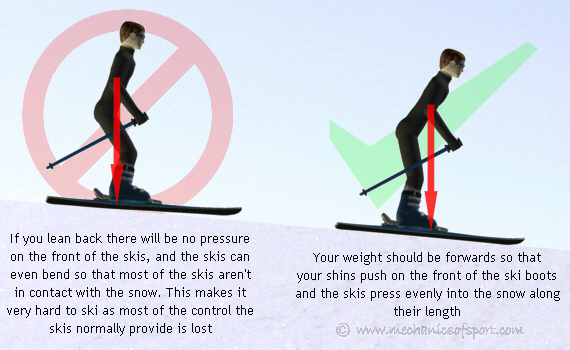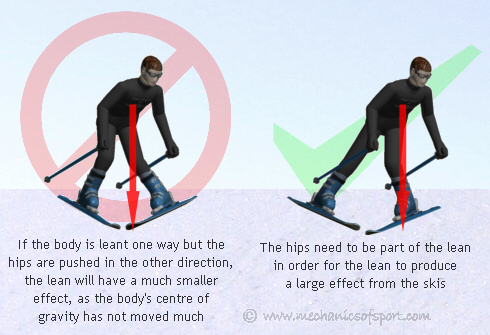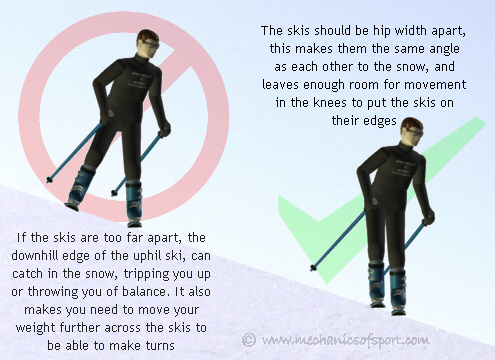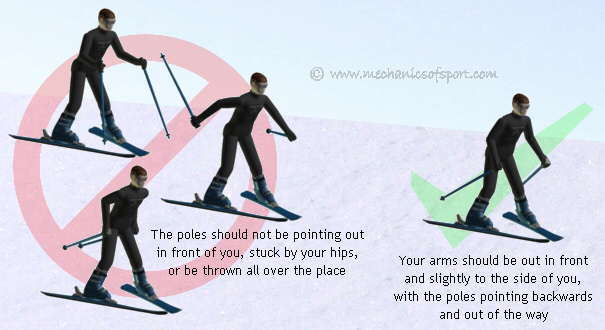Ski Turns Easy to the Left but Hard to Turn Right
Common Mistakes
When people learn to ski there are many common mistakes that they make, here many of them are listed with reasons why people make them, what happens when you make them, and a bit on what to try to stop yourself making them.
Leaning Back
Leaning back is probably the most common mistake that people make when learning to ski. The reason they lean back is normally very simple, they are afraid of the slope or the speed they have, and the natural reaction is to lean back to try and bring yourself further away from it. Leaning back causes many problems though, as soon as you don't push on the front of the ski boots the pressure on the front of the skis decreases giving you less control.

As shown in the diagram, when you lean back the front of the skis will stop pushing into the snow, and can even come into the air altogether. When the front of the skis are not pushing into the snow, it means that that part of the ski can not give you any control, and effectively makes you ski only using about one third of the skis. There is no simple solution to this other that to consciously make sure you can always feel your shins pushing on the front of the ski boots, and get used to positions you need to do this. Your weight needs to be over the front of your feet for the skis to push evenly into the snow along their length, and give you full control. This is also explained in the Longitudinal Weight Distribution section.
Not Leaning Far Enough
This is another mistake that is generally caused by fear, in order for manoeuvres to work properly the body's weight really does need to be put into the right position. If the body's weight is not moved far enough the effects that are needed for the manoeuvre will not be strong enough. If you want a quick and distinct effect from you skis, you really need to get your body weight over the right place and not be shy about it. This is also covered in the Lateral Weight Distribution section.

Moving The Hips
Moving the hips is often a more subconscious mistake, that people don't really realise that they are doing. This falls into the same category as not leaning far enough, as in this case the person does lean further, but they are afraid to put the right amount of weight on the skis, so although the upper body leans considerably in one direction, the hips move out in the other direction, and the overall effect is that the centre of gravity hasn't really moved much. The hips need to be part of the lean to help the body get as far over the outside ski as it needs to be.

Not Twisting The Body Down The Slope
This is a very common mistake, as most peoples default way of thinking is to think their body should be looking down the skis all the time. The body should be looking over the downhill ski, with the shoulders at the same angle as the tips of the skis. This position makes it easier to lean on the downhill ski, as well as keeping the body in a more flexible position and enabling you to see where you are going better. This is explained in more detail in the Stance section.

Looking at The Front of The Skis
This is another generally fear based mistake, that stops people from paying so much attention to where they are going, and instead concentrate on something that is not very important. Your attention should be on where you are going and therefore you should have your head up and be looking ahead, as for the front of the skis, you should be able to feel where they are without needing to look at them.

Having the Skis Too Far Apart
The skis should be hip width apart when they are parallel. This ensures that they are both at the same angle to the snow, and also means that the weight changes needed to make turns don't need to be so big. If the skis come too far apart the downhill edge of the inside ski can catch in the snow tripping you up or throwing you off balance. Having the skis hip width apart also leaves enough room to roll the knees so that the skis go onto the edges, which is very important if you want to dig the edges in to slow down, or to start carving.

Not Going Fast Enough
To be able to feel the forces and responses in skiing, you need to be going at the right speed. If you are not going fast enough it will take a lot longer for things to happen, and often they will happen so slowly that they you don't really realise what you did to cause the effect. If you are going at the right speed you should be able to throw you weight around a bit and find out what happens from every movement, feeling the responses of the skis.
Wimping Out
Skiing is a sport where going for it is very important if you want to learn quickly at all, of course what you are going for has to be suitable for your ability, but as long as you take ski lessons this should not be a problem as the instructor will only ask you to do things that you are ready for.
Not Having The Poles in The Right Position
So many people when they learn to ski start off holding the poles in all sorts of different positions which they shouldn't be in. Most commonly either pointing out in front of them, with their hands stuck to their hips or waving them about all over the place. Your arms should be out in front of you, slightly out to the side, with a slight bend in the elbows and the poles pointing diagonally backwards and downwards. The ends of the poles should be far enough above the snow that they shouldn't catch on anything.

On to the Piste Safety page.
Source: https://www.mechanicsofsport.com/skiing/learning_to_ski/common_mistakes.html
0 Response to "Ski Turns Easy to the Left but Hard to Turn Right"
Post a Comment